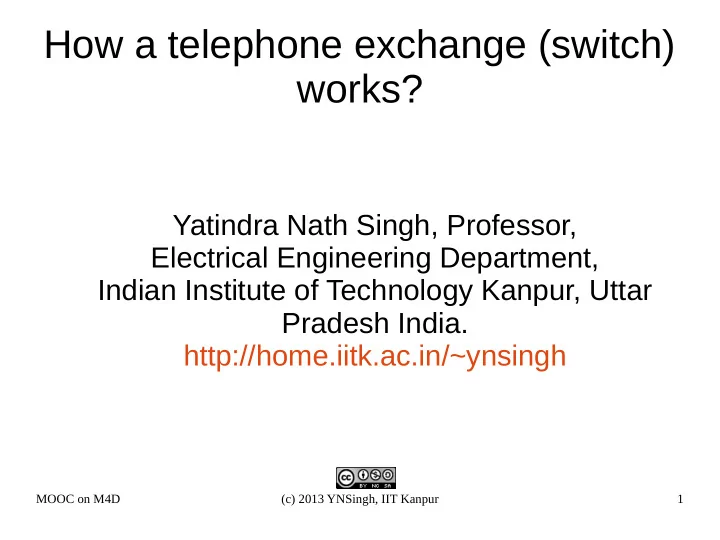

How a telephone exchange (switch) works? Yatindra Nath Singh, Professor, Electrical Engineering Department, Indian Institute of Technology Kanpur, Uttar Pradesh India. http://home.iitk.ac.in/~ynsingh MOOC on M4D (c) 2013 YNSingh, IIT Kanpur 1
Basic components of exchange ● Line interface card ● Switch matrix ● Switch Control MOOC on M4D (c) 2013 YNSingh, IIT Kanpur 2
Crossbar (space switch) ● Crosspoints for creating path between input and output ● Single input to multiple output (multicast possible) ● Each crosspoint – controlled by a relay ● Each crossbar control system – have status registers – keeping track of status of crosspoints. ● Activation of Row first, column second – snaps the crosspoint. MOOC on M4D (c) 2013 YNSingh, IIT Kanpur 3
● Deactivation of row, does not changes the status. ● Path created for information flow. ● Deactivation of column deactivates crosspoint. Path broken. MOOC on M4D (c) 2013 YNSingh, IIT Kanpur 4
● Crosspoint complexity – how the number of crosspoint grows with the number of input (output) ports. ● For crossbar, it is 2 ) O ( N ● The above switch – strictly non-blocking switch ● It can be used for analog signal as well as digital signal. MOOC on M4D (c) 2013 YNSingh, IIT Kanpur 5
Digital telephony ● At line card (if user have analog telephone) – analog to digital conversion (ADC) – from subscriber – Digital to analog conversion (DAC) – to subscriber ● In digital telephones – ADC/DAC functionality part of telephone instrument. ● Analog line card, digital line cards MOOC on M4D (c) 2013 YNSingh, IIT Kanpur 6
Analog-Digital conversion ● Voice is limited to 3.6kHz ● Sampled at 8000 samples/sec ● Each sample is quantized to 256 level (needing 8 bits in digital representation) ● 64 kbps voice stream ● 1 byte every 125 μs ● In telephony, all kind multiplexing structures have frame duration of 125 μs. MOOC on M4D (c) 2013 YNSingh, IIT Kanpur 7
Time Switch ● Voice samples from N users ● N octets in a 125 μ s frame. ● Write in order, read in an order governed by input-output mapping (WCRA – write cyclic read acyclic) MOOC on M4D (c) 2013 YNSingh, IIT Kanpur 8
● Write in an order governed by input-output mapping, read in order (WARC – write acyclic read cyclic) ● Time switch ● Control memory – decides the switching map. ● Switch control - Writes in the control memory. MOOC on M4D (c) 2013 YNSingh, IIT Kanpur 9
Strictly non-blocking switches ● Both the above configurations – strictly non-blocking ● If input and output ports are free – path between them can always be setup. ● For large size switches – lot of hardware can be reduced – by allowing some blocking. MOOC on M4D (c) 2013 YNSingh, IIT Kanpur 10
Blocking switches ● In some switch states, – even if input and output is free – still connection cannot be setup. ● We also have a variety – rearrangeably non-blocking switches ● If input and output is free – you can rearrange the existing paths in the switch while retaining the existing map – Thereafter one can always connect the input and the ouput. MOOC on M4D (c) 2013 YNSingh, IIT Kanpur 11
Network ● Distributed large switch ● Made with smaller interconnected switches ● Has redundancy – whole switch never fails even if few smaller switches fail. MOOC on M4D (c) 2013 YNSingh, IIT Kanpur 12
Current day scenario ● Link speeds are very high (goes upto 40 Gbps) – packets transmission time – small. ● Delay for sending a message from source to destination – much smaller now ● Voice, video – can be sent in realtime over packet switched network. ● Telephony has now evolved to use packet switching – VoIP (voice over IP) MOOC on M4D (c) 2013 YNSingh, IIT Kanpur 13
Recommend
More recommend